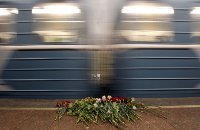Survivors of Moscow subway bombings still recover from horror
 Many Muscovites came to Lubyanka and Park Kultury stations of the Moscow metro in the morning of March 29 to pay tribute to the victims of the terrorist acts, which took place a year ago. Two suicide bombers exploded themselves on those stations early in the morning of March 29, 2010 killing 40 people. Metro employees arranged special tables at the platforms of the two stations so that people could lay flowers and light candles there in memory of the victims, Interfax reports.
Many Muscovites came to Lubyanka and Park Kultury stations of the Moscow metro in the morning of March 29 to pay tribute to the victims of the terrorist acts, which took place a year ago. Two suicide bombers exploded themselves on those stations early in the morning of March 29, 2010 killing 40 people. Metro employees arranged special tables at the platforms of the two stations so that people could lay flowers and light candles there in memory of the victims, Interfax reports.

Some people brought photographs of the victims and put them on the tables.
The explosions in the metro took place during a morning rush hour. There was an interval of 40 minutes between the two explosions. Forty people were killed, 160 others were wounded. The two female terrorists were identified as Janet Abdurakhmanova (Abdullayeva), born in 1992, Dagestan, and Mariam Sharipova, born in 1982, also a native of Dagestan. The organizer of the blasts, Madomedali Vagabov, was killed in August of 2010 in a counter-terrorist operation in Dagestan.
A year later, officials of the Investigation Committee of the Russian Federation said that all organizers and executors of the Moscow metro bombings had been identified. Six of them have been killed. Another one, Daud Magomedov, killed himself in the town of Kizlyar in the spring of 2010.
Only one terrorist of the group is still alive and free. He is a 22-year-old resident of Dagestan, Gusen Magomedov. Law-enforcement officers said that it was him who accompanied the two suicide bombers from Kizlyar to Moscow. The man also supervised their actions during the day when the terrorist acts were performed.
Those people, who survived the bombing in the Moscow metro, shared their memories with the Komsomolskaya Pravda newspaper. Many of them suffer from hearing disorders, others still recover from their injuries. Some of the survivors said that it seemed to them during the first moments after the explosion that they were the only survivors who were riding the same train carriage with the bombers.
Artyom Medvedev, a 19-year-old student of the Moscow Railway Institute, was standing next to the bomber for a while after he took the train several minutes before the blast.
"The people around us thought that that woman was pregnant. They even tried to offer her to sit down. She refused. I remember that her eyes were moving very fast, it was clear that she was being very nervous. I stepped away from her instinctively," the man said.
The woman blew up the bomb in less than a minute.
"I came to my senses and realized that there was blood flowing from my mouth. The pain in the head was unbearable," the young man said.
Artyom suffered serious injuries. Metal pieces in the bomb wounded him in the face, injured his back, legs and the jaw. However, the young man got onto his feet and went out of the station himself.
Tatiana Grinina, a 61-year-old woman, is still recovering. The woman suffered a leg injury and learns how to walk again.
"The explosion ripped a piece of my shin muscle out. I remember there was a man who helped me out of the carriage," the woman said.
Viktor Krivosheev, a driver, was more lucky than others.
"During the first moment after the explosion I thought that I was the only survivor. When I came to my senses, I smelled burnt hair. I began to look around but could not see anyone alive near me," he said.
Viktor did not suffer any serious injuries, but he spent two months at hospital restoring his hearing.
Natalia Svetikova, 25, came out of the carriage at the moment when the explosion occurred.
"Pieces of hot metal injured my right arm. The whole right sleeve of my jacket was covered with holes. I pulled the sleeve up and saw many wounds on my arm," the young woman said.
In addition to strong headaches, Natalia now suffers from the fear of the metro. She took a ride in the metro only once during the year after the explosion.
AP photo
Subscribe to Pravda.Ru Telegram channel, Facebook, RSS!


